ASM Metals HandBook Vol. 8 - Mechanical Testing and Evaluation
Подождите немного. Документ загружается.

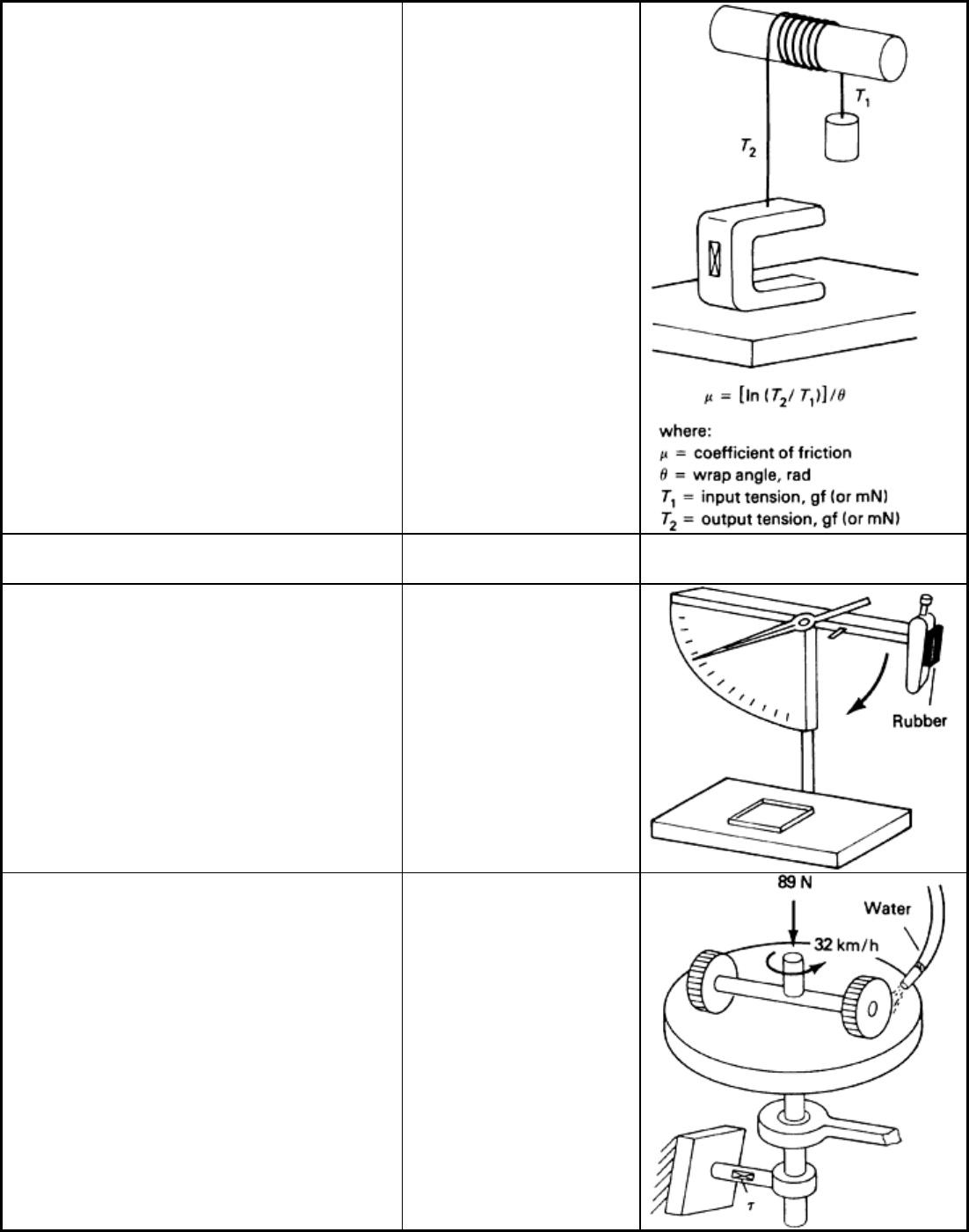
D 3412 (D-13 on textiles), Coefficient of
Friction, Yarn to Yarn
Continuous filament and
spun yarns self-mated (μ
s
and μ
k
)
D 4103 (D-21 on polishes), Preparation of
Substrate Surfaces for Coefficient of Friction
Vinyl and wool tiles
(preparation only)
Any apparatus
E 303 (E-17 on traveled surfaces) Measuring
Surface Frictional Properties using the
British Pendulum Tester
Rubber versus pavement
(BPN, British pendulum
number)
E 510 (E-17 on traveled surfaces),
Determining Pavement Surface Frictional
and Polishing Characteristics using a Small
Torque Device
Rubber versus pavement
(TN, torque number)

E 670 (E-17 on traveled surfaces), Side
Force Friction on Paved Surfaces using the
Mu-Meter
Tires versus pavement
(μ) (F
dry
- F
wet
)
E 707 (E-17 on traveled surfaces), Skid
Resistance of paved surfaces using the North
Carolina State University Variable Speed
Friction Tester
Rubber tire versus
pavement (variable speed
number)
F 489 (F-13 on footwear), Rating of Static
Coefficient of Shoe Sole and Heel Materials
as Measured by the James Machine
Leather and rubber sole
and heel material versus
walking surfaces (μ
s
)
F 609, Test Method for Static Slip
Resistance of Footwear, Sole, Heel, or
Related Materials by Horizontal Pull
Slipmeter (HPS)
Footwear materials
versus walking surface
(μ
s
)
F 695-81 (F-13 on footwear), Evaluation of
Test Data Obtained by Using the Horizontal
Slipmeter or the James Machine for
Measurement of Static Slip Resistance of
Footwear, Sole, Heel, or Related Materials
Footwear materials
versus walking surfaces
(reliable ranking of
footwear for slip
resistance) (μ
k
)

F 732 (F-4 on medical and surgical
materials), Reciprocating Pin-on-Flat
Evaluation of Friction and Wear
Properties of Polymeric Materials for Use
in Total Joint Prostheses
Materials for human
joints (μ
k
)
(a) Note: Used with permission of the G-2 Committee on Wear and Erosion
Microscale Friction Tests. In recent years, the ability to perform friction-type tests at scales approaching the
atomic level has been developed in research laboratories. This field has been called “microtribology” or
“nanotribology.” Microscale tests address a special class of friction and adhesion problems. The results can fail
to directly agree with test results on similar materials conducted at more macroscales of contact, such as those
described in Table 1. Fine- scale friction test results can relate to such applications as thin films on computer
hard disks, read-write heads, and microelectromechanical systems (MEMS). They can provide information on
the behavior of monolayers of lubricating films, but they tend not to be able to address issues such as particulate
contamination and embedment effects, microstructural inhomogeneity, thick film behavior, and surfaces with
the scales of roughness typical of many present-day engineering components. Therefore, it is important to
conduct such fine-scale tests with a full understanding of the implications and limitations of the results.
In conducting microscale friction tests, the typical apparatus contains an elastic beam of some kind on which a
needlelike probe is affixed. A full range of materials is not generally available in the form of these tiny slider
tips, so the ability to examine many different material combinations is limited. There are various sensing
modes, some of which reflect a laser beam off the back side of the elastic beam and measure its deflection to
infer the bending force produced by frictional drag. In other cases, capacitive sensors or piezoelectric sensors
are used. Providing details on these specialized, largely basic-research oriented test methods is beyond the
scope of this article. The reader is referred instead to Ref 6 and the article by R.G. Horn in Ref 3 for more
details.
Friction Testing under Well-Lubricated Conditions. If sliding members are fully separated by a film of lubricant
(oil, water, gas, and so forth), the friction coefficient of the system is essentially the friction coefficient of the
fluid. When boundary lubrication exists, the surfaces are partially in contact, and the coefficient of friction of
the system is a function of the combined properties of the fluid and surfaces. When dry-film lubricants are used,
the friction coefficient of the system can be related to the properties of the dry-film lubricant slipping on itself
or to those of an uncoated solid on the lubricant film. Lubrication with graphite, molybdenum disulfide, or
fluorocarbons is an example of this.
With fluid separation, the friction coefficients can be several orders of magnitude lower than they are for
systems that involve solid contact. The Stribeck-Hersey curve shown in Fig. 8 allows calculation of the
coefficient of friction from lubricant properties (ηN/P), where η is the viscosity, N is the velocity, and P is the
pressure (load). Empirical measurement of friction in film-separated systems is complicated by the need to
maintain the fluid separation. With oils and greases, it usually involves testing at high velocities. If
circumstances allow, the use of a friction coefficient calculated from the fluid parameters is much easier.
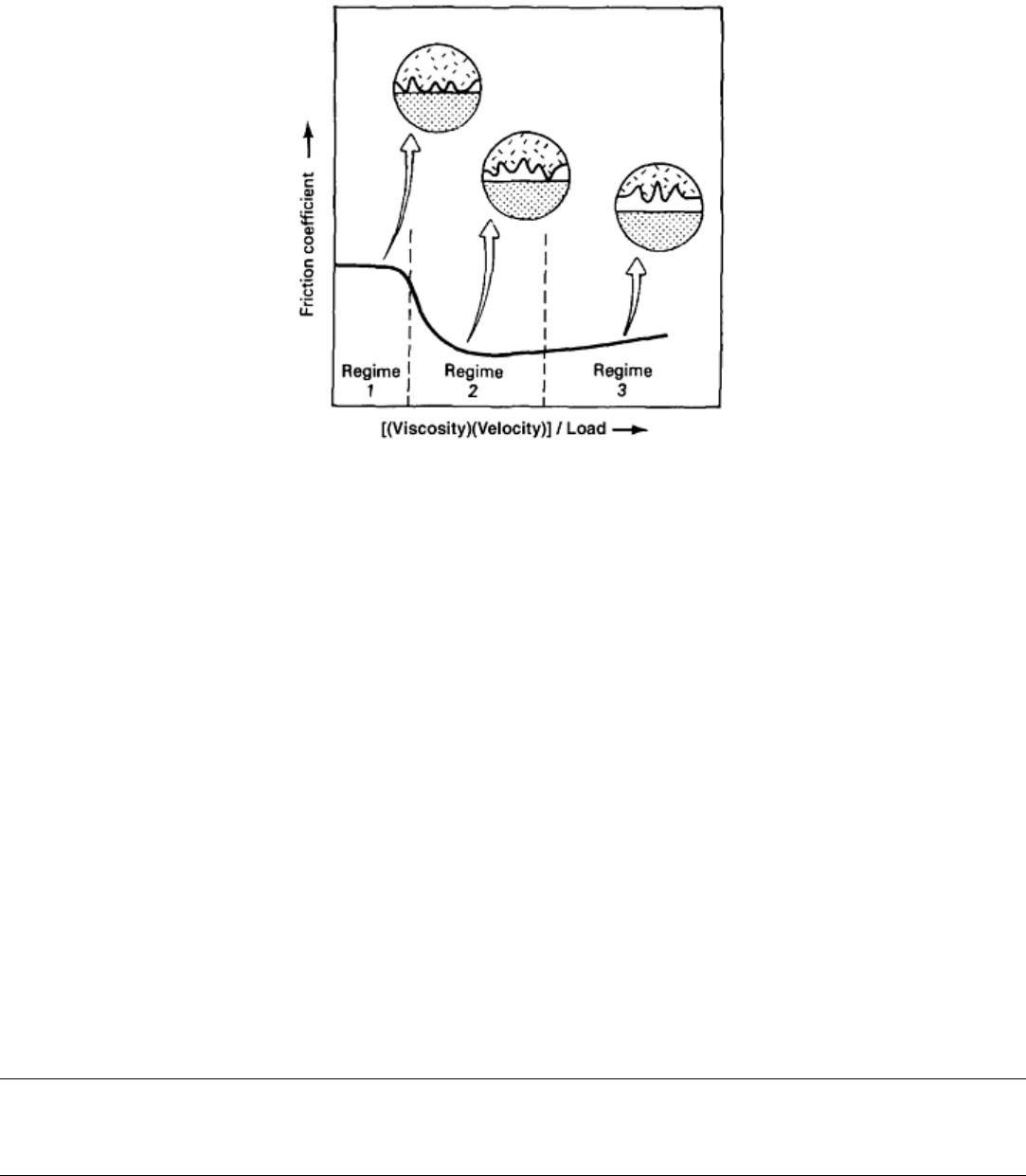
Fig. 8 Plot of friction coefficient, μ, versus [(viscosity)(velocity)]/load, (η
0
U)/P, to show range of the three
regimes of lubrication. Regime 1, boundary lubrication; regime 2, thin-film lubrication; regime 3, thick-
film lubrication
A number of test methods, like the lubricated block-on-ring test (ASTM D 2714) and the four-ball test, are used
for determining the effects of lubricant additives on frictional behavior. A pin-in-Vee block test is used for
assessing load carrying capacity and seizure. Additional information on lubricant friction testing is available in,
for example, the ASTM standards developed by committee D-2 and in Ref 7.
References cited in this section
2. A.Z. Szeri, Tribology: Friction, Lubrication, and Wear, Hemisphere Publishing Corp., 1980, p 2
3. Friction, Lubrication, and Wear Technology, Vol 18, ASM Handbook, ASM International, 1992
5. E. Rabinowicz, Friction Coefficients of Noble Metals over a Range of Loads, Wear, Vol 159, p 89
6. B. Bhushan, Handbook of Micro/ Nanotribology, 2nd ed., CRC Press, Inc., 1998
7. R. Booser, Ed., CRC Handbook of Lubrication, Vol 1–3, CRC Press, Inc.
Testing Methods for Solid Friction
K.G. Budinski, Eastman Kodak Company; P.J. Blau, Oak Ridge National Laboratory
Performing a Valid Test
The procedural considerations that should be addressed to ensure that valid data are derived from a friction test
are discussed in this section. Investigators often run a friction test that is convenient to use but that has no
resemblance to the system under study. Friction is a system property, and systems must be modeled carefully
(same materials, same surface treatments, and so forth). Other factors that can affect the validity of a friction
test include sample preparation, method of friction measurement, and interpretation of data.
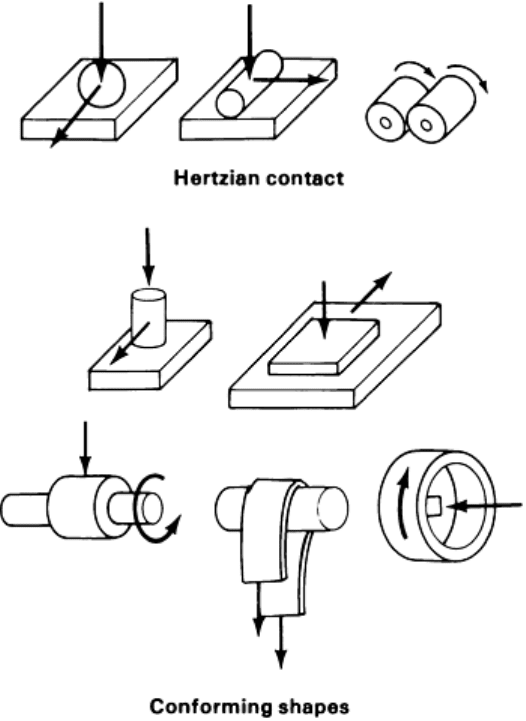
System Modeling. Essentially three types of geometries prevail in systems where friction is a concern. These
include:
• Hertzian contact
• Flat-on-flat
• Conforming surfaces (belt on a drum, plain bearings, and so forth)
These systems are illustrated in Fig. 9. It could be argued that when wear occurs, all surfaces become
conforming. This is true for all systems except those where the triboelements remain Hertzian in contact. For
example, railroad wheels wear significantly in service, but they still contact the track in a Hertzian manner by
line or point contact. With regard to wear of the sliding surfaces, this can be the most important aspect of
modeling a tribosystem. If the system under study will wear, and it is the desired goal of the study to determine
the friction characteristics under conditions of steady-wear, friction should be measured in a wear test. If the
system of concern will not change with time, a friction test that does not involve wear can be conducted. Figure
10 shows how wear can affect friction forces. Figure 10(a) illustrates the friction force variation with time for a
system that does not experience any wear or changes in behavior when wear occurs. If, for example, paper is
conveyed over a fixed roller with a smooth finish, it is highly likely that the friction force will remain the same
as the roller wears by polishing abrasion, and the friction force will be constant with time, as will the nature of
the tribosystem. The roller constantly wears, but the surface is always polished. The wear debris is carried away
with the product, and nothing in the system changes. This statement must be qualified by noting that the
environment (humidity, temperature, and so forth) can cause friction to change with time. Environmental
effects are discussed later in this article.
Fig. 9 Friction test specimen configuration options
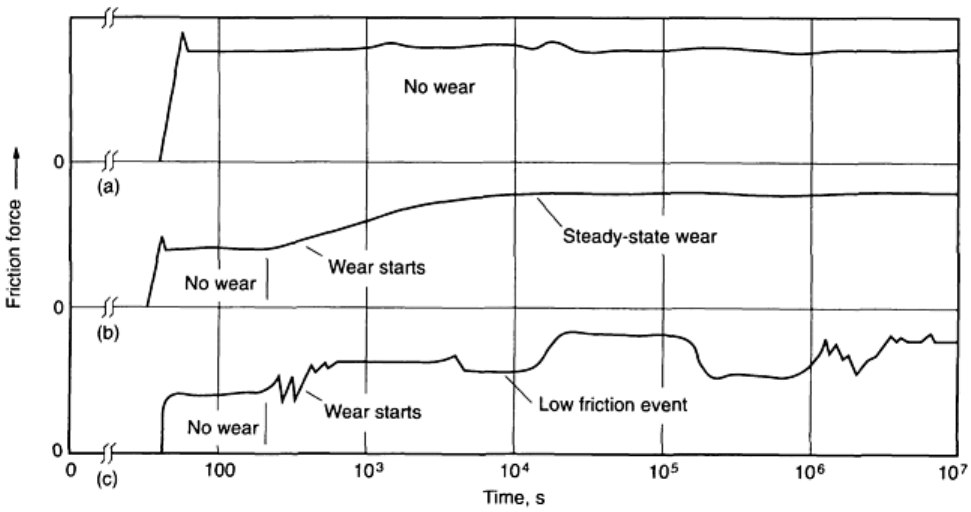
Fig. 10 Effect of system wear on friction force. (a) System that does not experience any wear or changes
in behavior when wear occurs. (b) System where friction force increases with time until reaching a
steady-state conditions. (c) System where friction force varies with each event in the wear process
Figure 10(b) illustrates a tribosystem where the friction force increases with time and then reaches steady state.
This type of behavior might occur in a system experiencing severe wear. Friction is low when both members
have their original surfaces. When the original surfaces start to wear, friction increases, and from that point on,
the worn surfaces remain the same. It is comparable to a machining operation in that material is constantly
being removed, but the cutting forces remain constant.
Figure 10(c) illustrates a system where the friction force varies with events in the wear process. This type of
behavior often occurs in a tribosystem where wear debris remains in the system. Depending on how it separates
the surfaces, wear debris can have lubricating or nonlubricating effect on the system. The friction will be
constant when the triboelements have their original surfaces; when they wear, there will be a friction event
followed by another when both surfaces become coated and are separated by wear debris. Because wear is a
statistical process, some other event can take place to remove the separating wear debris, and still another cycle
or friction event will occur. This phenomenon is seen in many machines. The machine can run quietly for a
year, but then a squeal occurs that lasts for two weeks and then stops. The noise can come back in two months,
or it might never return. It is quite possible that significant fluctuations in friction force with time are the result
of environmental events. For example, it is well documented that the friction characteristics of photographic
films are significantly affected by relative humidity. Photographic emulsions are gelatin based. Many gelatins
have mechanical properties that are directly proportional to their water content. Mechanical properties vary
with humidity, and these property changes in turn affect friction characteristics. Temperature has a similar
influence on many materials, particularly plastics.
The illustrations shown in Fig. 10 are presented in order to emphasize that it is important to closely model the
system under consideration. The test should simulate the mode of contact and the environment, and the length
of time that the system is tested should be typical for the intended service. If new materials are being screened
for friction characteristics, short-term and long-term tests should be conducted to explore friction events that
change with time. If a service problem is being studied, the test should simulate the important aspects of the
service, the environment, the type of contact, and the materials. It is not necessary to exactly duplicate the
sliding speed and load unless they are likely to change some properties of the test materials (temperature,
chemical environment, and so forth).
Material Documentation. Problems concerning repeatability of a friction test with time can be related to subtle
or major changes in the nature of one of the tribocomponents. For this reason, it is important to provide
adequate documentation of the materials in a tribosystem where friction measurement is the goal. As shown in
Table 2, the necessary documentation varies with the type of material (metal, plastic, ceramic, or composite).

Table 2 Material parameters that should be documented to ensure repeatability when testing
tribosystems
Metals
• Chemical composition
• Manufacturer name and address
• Manufacturing process [wrought (cold finished or hot finished), cast, extruded, etc.]
• Generic designation
• Trade name (if applicable)
• ASTM or similar designation
• Condition of heat treatment
• Surface finish
• Surface treatments
• Grain direction
• Microstructure
Plastics
• Polymer species (If a blend, state ratio of blended polymers)
• Fillers, lubricants, and so forth (percentage)
• Manufacturing process (injection molded, extruded, cast)
• Generic name
• Applicable specifications (MIL, ASTM, and so on)
• Trade name and manufacturer number
• Manufacturer name and address
• Process used to generate wear surfaces, orientation of wear surfaces to original shape (wear
surfaces flatwise on as-molded flatwise plate, wear surfaces end grain in extruded shape, and so
on)
• Lubricants on the surface or in the material
• Surface texture of wear surface or in the material
• Surface texture of wear surfaces (R
a
, lay, waviness)
• Heat treatments applied
Composites
• Detailed description of composite components (filament winding details, number of plys,
components in laminate)
• Generic name and applicable specifications on composite components
• Trade names of components
• Manufacturer name and address
• Method of manufacture
• How wear surfaces were generated
• Orientation of wear surfaces to reinforcement
• Heat treatments
• Surface texture (R
a
, lay, waviness)
• Surface treatments, lubricants, mold releases, and so forth
Ceramics
• Basic type and composition
• Percent theoretical density
• Manufacturer name and address
• Trade name
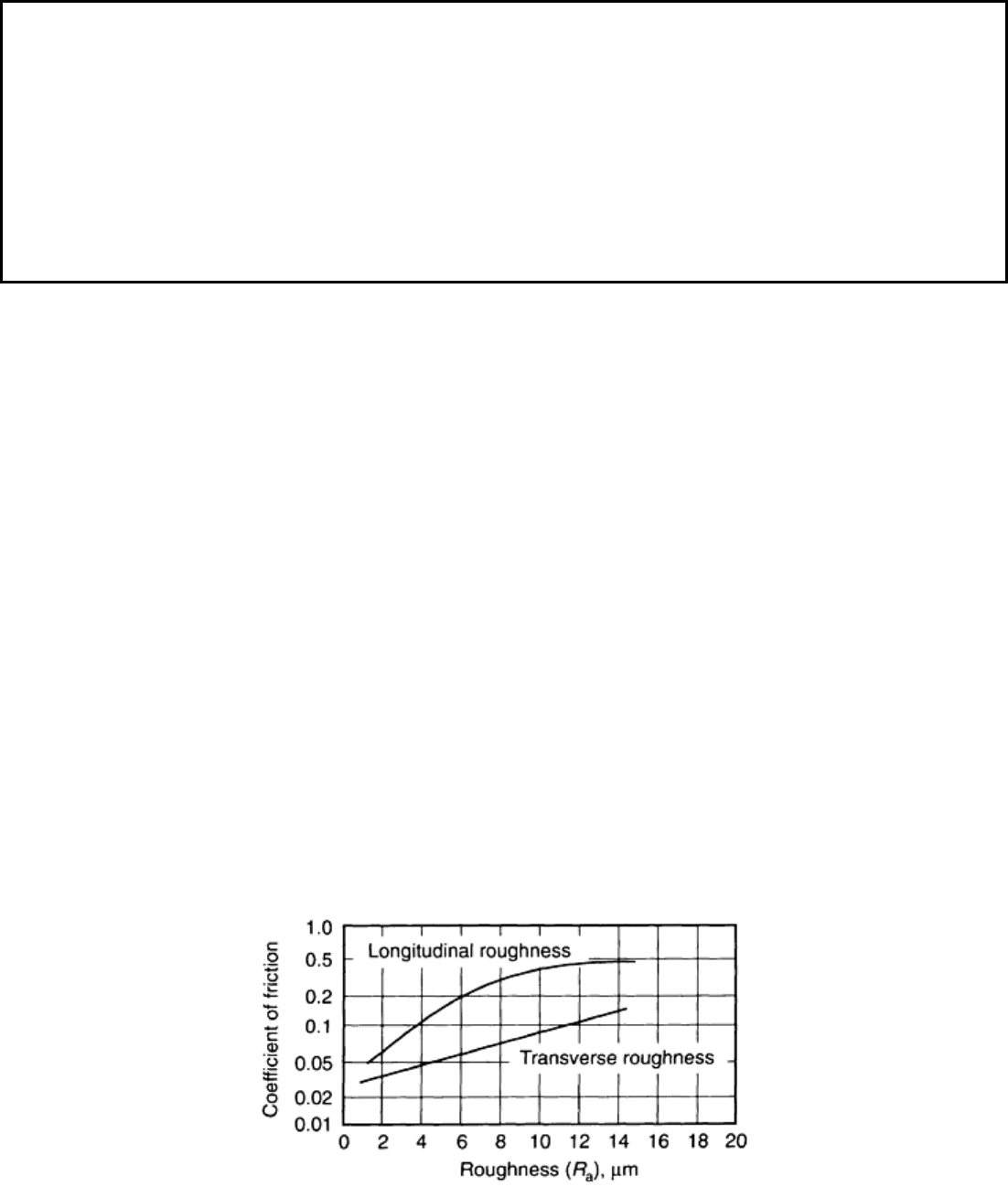
• Manufacturing process (HIP, vacuum sintering, chemical vapor deposition, and so on)
• Method used to generate wear surfaces (grinding, polishing, and so on)
• Texture of wear surfaces (R
a
, lay, waviness)
• Heat treatment
• Surface treatments
• Grain size
• Microstructure
• Morphology (degree of crystallinity, phases present, crystal structure)
• Lubricants/impregnants
R
a
, surface roughness in terms of arithmetic average
More items undoubtedly could be added to Table 2, but the point to be made is that all of the variables that have
been mentioned thus far could affect sliding friction. If the surfaces are lubricated, the tester must add related
details of the type of lubricant and its distribution on the sliding surfaces. It is imperative that documentation on
all members in the tribosystem be included. It is quite easy to cite examples where each of the factors listed in
Table 2 has affected friction results in laboratory tests; more importantly, these factors influence friction
properties in service. Heat treatment, structure, and so forth can affect mechanical properties. Surface films
affect sliding forces; surface texture affects early friction. A cast polyester has different mechanical properties
than a tentered and drafted polyester web, and a hot isostatically pressed silicon carbide has different
mechanical properties than pressed and sintered material. The tester should be meticulous about material
documentation.
Surface Condition. Few tribologists will argue with the statement that friction can be affected by surface
condition. If the loads are light enough, only the outer one or two mono-layers on the surface might take part in
sliding interactions. In lubricated systems, surface roughness plays a role in determining whether the surfaces
are separated. Full-film separation will not occur unless the film thickness is greater than the composite surface
roughness. Even with hydrodynamic lubrication, there are some investigators who claim that the system friction
is affected by the surface roughness and lay (Fig. 11). In the normal range of roughness on rolling-element
bearings and plain metal bearings (0.1 to 1 μm R
a
), it is likely that the surface features do not significantly
affect lubricated sliding. In nonlubricated sliding, the effect of roughness can be negligible to significant,
depending on the system (Ref 8). With normal machined surfaces with a roughness less than about 1.5 μm, the
effect will be slight. Roughness becomes a meaningful factor when the roughness interactions result in
mechanical locking effects. This usually happens only with very rough surfaces. Sometimes, very smooth
surfaces cause adhesion— for example, gage blocks or plastic webs on smooth surfaces. Conversely, in some
applications such as high-speed sliding of yarns and filaments over stationary guide pins, the friction coefficient
is low when the pin surfaces are rough (0.5 to 2 μm R
a
) and becomes very high when the pins become polished
from wear.
Fig. 11 Effect of surface roughness on the friction coefficient of a lubricated sliding system. Adapted
from Ref 8
A valid wear test considers the effect of surface texture. For many systems, the effect is not significant. If,
however, surface texture is considered a variable for a given wear study, a few quick tests using the high and

low of the expected range of surface texture will determine whether this is a parameter to be pursued in a
friction study.
Surface films are important in most tribosystems, especially unlubricated systems. The recommended practice
in friction testing is to leave the films in place if they are likely to occur in the tribosystem of interest. If they
are not part of the system of interest, they should be removed by cleaning. Valid wear results require that a
cleaning procedure be used that will remove contaminants and not leave another contaminating film. The
cleanest surface is the as-machined or as-ground surface (without coolants and the like). These types of surfaces
prevent cleaning-solution contamination problems. If metal surfaces must be cleaned of contaminating films,
then a refluxed solvent system should be used. Plastics are difficult to clean with solvents because of the risk of
chemical alteration of the surface. Commercial glass-cleaning solutions have been employed to clean plastic
test surfaces with favorable results. Ceramics can also be cleaned by these solutions. Sometimes even water-
based cleaners can chemically alter a ceramic surface. The safest technique for removing contaminants on
ceramics is dry lapping or similar abrasive finishing.
Absorbed films from the atmosphere can be another source of contamination. To cite an example, many plastics
were tested in a comprehensive laboratory program as a track material for conveyance of plastic parts. Test
results indicated that an ultrahigh-molecular-weight poly-ethylene had the lowest friction. Hundreds of feet of
this track were installed in the manufacturing plant, but within a month the track was pulled out and replaced
because of an environmental factor that had not been considered during laboratory testing. Although there were
no problems with the track during the week when there was a three-shift operation, after the weekend, parts
would stick to the track with great frequency. Only after several hours of downtime and frequent “nudging” of
the parts would the system begin working properly. Further study indicated that when the track material was
allowed to sit idle for a period of 48 h, some type of film formed that deleteriously altered the friction
characteristics.
This example points out the importance of carefully duplicating the system environment, even to the extent of
allowing surfaces to sit idle in production environments. Many manufacturing plants have an atmosphere that
can leave a condensate on a surface. If this is likely to occur in a tribosystem under study, then it should be
made part of the friction testing.
Reference cited in this section
8. Y.-R. Jeng, Experimental Study of the Effects of Surface Roughness on Friction, Tribol. Trans., Vol 33
(No. 3), 1980, p 402–410
Testing Methods for Solid Friction
K.G. Budinski, Eastman Kodak Company; P.J. Blau, Oak Ridge National Laboratory
Test Parameters
Friction test parameters, such as speed and load, should be as close as possible to actual conditions. Sometimes,
however, it is difficult to simulate these parameters in a laboratory environment. The speeds and loads can be
out of the range of the lab equipment, or testing at actual conditions might take too long. A valid friction test
does not require that speeds and loads be exactly duplicated. Friction coefficients are relatively insensitive to
speed and loads up to the point where these parameters affect the properties of the test surfaces. Speed will
affect friction results on most metals when it is sufficiently high to soften the surface and alter mechanical
properties. With plastics, this temperature can be only a few hundred degrees Fahrenheit. With metals, the
critical temperature is close to the stress-relief temperature for a given alloy.
Sliding speed for a friction test can range from 10 mm/s (0.4 in./s) for an inclined plane test to 100 m/s (325
ft/s) for high-speed yarn friction tests. For optimum results, test equipment should yield a wide range of sliding
speeds. If the actual operating speed is unusually high or low, unique friction conditions can be produced that
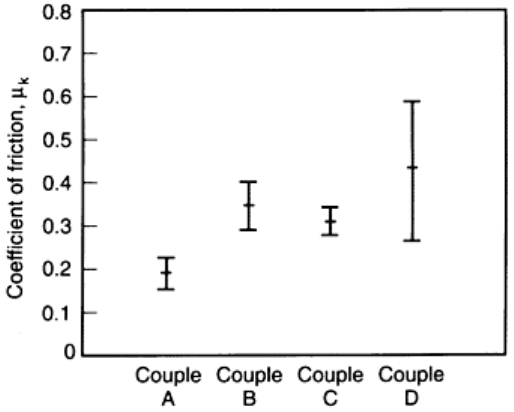
can be simulated only by test speeds in the range of concern. For example, a laboratory study was conducted on
plastic and competitive plain bearings for a compact-disk drive scanner that had to slide (bushings versus
hardened steel shafts) in a linear motion at a speed of 1.6 μm/s (0.00006) in./s). The slow speed caused many
materials to display stick-slip behavior. When higher speeds were used, this did not occur. Under such
conditions, the speed of the tribosystem should be duplicated as closely as possible.
The same type of reasoning should be applied to test loads. If a system under study uses loads of only a few
grams, this should be duplicated. If the system under study is subject to extreme forces, such as those that occur
in threaded fasteners, there is little recourse other than to use these very high forces. When studying bolt
friction, most investigators use actual bolts and nuts and a washer equipped with a strain gage for measurement
of bolt tension. This is because of the difficulty in obtaining a bench-top friction tester that can apply a 45 kN
(10,000 lbf) normal force.
As a rule of thumb, if it is not possible to simulate the service load, then the highest load that does not exceed
the compressive strength of either member in the test couple should be used. This is particularly applicable to
Hertzian loading situations. If the compressive strength of the material is exceeded, the friction test only yields
the forces to plastically deform the surfaces. Test speeds and loads that produce significant wear should be
avoided unless that is part of the tribosystem under study.
As previously mentioned, friction force might not be constant throughout a test, and questions can arise as to
the value that should be reported. The most meaningful data are the minimum, the maximum, the mean, and the
standard deviations. These allow the use of statistical analysis to determine whether friction coefficients for
various systems are really different. Erratic systems such as that described in Fig. 10(c) will be treated with
statistics. In friction tests where the goal is to find a couple with the smoothest motion, a suitable test parameter
for ranking materials is the standard deviation of the friction force. This shows the variability of the friction
forces for the various systems. In fact, for all friction tests it is recommended that statistical tests be used. The
simplest test of differences is illustrated in Fig. 12. If the mean of test data is plotted with error bars coinciding
with plus or minus two standard deviations, a visual test of differences can be made. If the error bars overlap,
the test results are not statistically different. In Fig. 12, couples B, C, and D have the same frictional
characteristics; only couple A differs.
Fig. 12 Graphical use of statistics to show differences in friction coefficients between various material
couples
Sample size must also be considered in statistic tests. There are a number of ways to calculate sample size, but
most statisticians prefer a large number (for example, 40) of replicate tests. Because most friction tests are very
repeatable within a laboratory, this number may be a bit high. Most studies using a bench-top friction tester can
have statistical accuracy with as few as 10 replicates per system.
